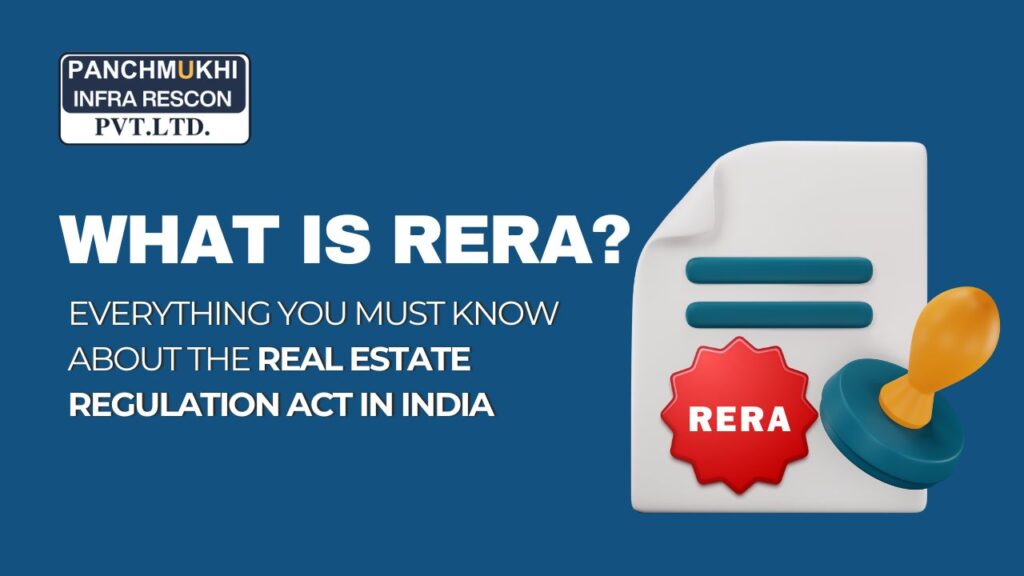What is RERA? Everything You Must Know About the Real Estate Regulation Act in India

Buying a home is a big deal, right? But let’s be honest—real estate in India hasn’t always been easy or fair for buyers. Delays, broken promises, and unclear terms were all too common. That’s where RERA comes in. If you’re wondering what is RERA and why everyone keeps talking about it, don’t worry—we’ve got you covered. This blog will break it down in a simple way so you know exactly what RERA is and why it matters to anyone buying or investing in property.
What is RERA?
RERA stands for the Real Estate (Regulation and Development) Act, 2016. It was introduced by the Government of India to bring order and fairness to the real estate world. Before this Act, builders could delay possession, change project plans, or even ghost you after taking hefty advances—yes, it was that bad.
But with RERA in place, there’s now a proper legal structure in place to regulate real estate projects and make builders more accountable. It’s like the rulebook that both developers and homebuyers must follow.
Why Was RERA Even Needed?
To put it bluntly—real estate in India was a bit of a mess. Projects would stretch endlessly, and there were hardly any safeguards for the average buyer. You couldn’t even be sure if your dream home would turn into a real one.
So, here’s what led to the birth of RERA:
- Massive delays in possession
- Lack of transparency in project details
- Builders diverting funds to other projects
- No standardization in how space was measured (remember “super built-up area”?)
- Buyers had no legal recourse against powerful developers
In short, people were getting cheated, and something had to be done. That “something” turned out to be RERA.
Core Features of the RERA Act You Should Know
This law isn’t just a fancy piece of legislation—it’s packed with features that actually matter to real people. Here’s what makes RERA a real game-changer:
- Mandatory registration of real estate projects and agents with the state RERA authority.
- Developers must deposit 70% of the funds collected from buyers in an escrow account. That money can’t be used elsewhere.
- Advance booking amount capped at 10% before signing the agreement.
- All details regarding project plan, layout, approvals, land status etc. must be disclosed.
- Carpet area (actual usable space) is now the standard. Say goodbye to “super built-up” confusion.
- Strict penalties and even jail for defaulting developers.
- Buyers can get refunds, compensation, or interest in case of delays or fraud.
Honestly, these features made the whole buying process a lot safer.
What is an Escrow Account in RERA?
An escrow account is basically a special bank account where the builder has to keep 70% of the money they collect from homebuyers for a particular project. But why?
Well, before RERA came in, many builders would collect money from one project and use it to fund other projects or their personal stuff. This led to crazy delays and even incomplete buildings. Homebuyers had no clue where their money was going.
With RERA rules, that’s no longer allowed.
Here’s how the escrow account works:
- When you pay money to the builder, 70% of it goes into this protected account.
- That money can only be used for construction and land-related costs of that specific project.
- The builder can’t touch it freely—they need to provide proof (like progress reports) to withdraw money from it.
- This ensures your money is used responsibly and the project actually gets built.
Think of the escrow account like a safety locker for your money—accessible to the builder, but only when certain conditions are met.
Why RERA is Great News for Homebuyers
RERA didn’t just clean up the builder’s act—it empowered regular people. Here’s why this law is such a relief if you’re planning to buy a home:
- You can track the status of a project online.
- Builders can’t make random changes to plans without your consent.
- You’re legally entitled to compensation if there’s any delay.
- Builders can no longer vanish with your money.
- No more getting fooled by vague measurements—carpet area is clear and standard now.
- Even post-possession, you’re covered. Builders must fix any structural defects for 5 years.
Let’s just say, buying a home now feels a bit less like playing roulette.
Also read: Circle Rate vs Market Rate: What’s the Real Difference in Property Pricing?
Top Mistakes Buyers Make Even After RERA
Just because RERA exists doesn’t mean you can sit back and relax. Some people still fall into traps simply because they assume everything’s safe now. Here are a few common goof-ups to watch out for:
- Not checking RERA registration at all
Don’t just take the builder’s word for it. Look it up on the official site, especially if you’re buying in places like Dehradun. Ask for the registration number and verify it yourself. - Trusting the builder blindly
RERA enforces rules, but some builders still bend them creatively. Always read the documents carefully—even the boring parts. - Ignoring project updates
Most state RERA portals list project progress updates. If the builder isn’t updating it, that’s a red flag. - Skipping legal review
Even with RERA, having a lawyer check the agreement can save you from nasty surprises later. - Not raising complaints on time
If something feels wrong, act early. Don’t wait until things get out of hand—RERA works, but only if you use it.
Basically: RERA helps, but your awareness helps more.
Builders, It’s Not a Free Run Anymore
Developers now have to play by the rules. RERA holds them responsible like never before.
Here’s what they’re expected to do:
- Register every project before they even advertise it.
- Share complete, truthful info about everything—from layout to legal approvals.
- Stick to the promised timeline.
- Deliver what they committed—no surprise changes mid-way.
- Address buyer complaints even after possession (for 5 years!).
It’s not just about punishing wrongdoing; it’s about building trust in the entire system.
What Happens When Builders Break the Rules?
Ah yes, this is a really important question. When a builder violates RERA norms, here’s what can happen:
- Fines up to 10% of the project cost.
- Imprisonment up to 3 years.
- The buyer can file complaints with the RERA authority and even appeal in the Appellate Tribunal.
- RERA also has the power to stop or revoke registration of the project.
So yeah, RERA means business. It’s not just a paper tiger.
RERA vs Pre-RERA: What’s Changed?
Let’s take a quick look at how things have shifted:
Feature | Before RERA | After RERA |
Project Delays | Rampant, with no accountability | Strict penalties for delay |
Information | Often incomplete or false | Full disclosure required |
Area Calculation | Super built-up chaos | Carpet area standardization |
Buyer Protection | Weak | Strong legal safeguards |
Complaints | No dedicated authority | Fast-track RERA tribunals |
In one line—things are way better now.
How Builders & Agents Register Under RERA
Just for curiosity’s sake, here’s a glimpse into how developers and agents register under RERA:
- Submit application to state RERA authority
- Upload documents: land title, layout plan, NOCs, etc.
- Pay registration fee (varies by state and project size)
- Provide project timelines and financial details
- Wait for approval and get registration number
Without this, they can’t legally advertise or sell.
RERA Isn't Perfect—Let’s Be Real
Of course, no system is flawless. Even RERA has its fair share of challenges:
- Not all states have fully functional RERA setups.
- In some cases, complaints still take time.
- Many buyers are still unaware of their rights under RERA.
- Smaller builders sometimes find it hard to comply due to cost.
Still, as a step in the right direction, RERA is a solid foundation.
Misconceptions About RERA
Even though RERA has changed a lot in real estate, people still get a few things wrong. Let’s clear that up.
- “RERA guarantees timely delivery.”
Not always. While RERA pushes developers to meet deadlines and punishes delays, it doesn’t guarantee on-time possession. Some delays can still happen due to legal or environmental issues. - “Every project in India is RERA registered.”
Nope. Small projects under a certain size (typically less than 500 sq. m or 8 apartments) may be exempt. Always check if your specific project is covered. - “Once I complain to RERA, my issue will be resolved fast.”
RERA aims for quicker justice than courts, but resolution can still take weeks or even months depending on the state and complexity. - “RERA replaces all consumer rights laws.”
Not true. RERA works alongside other laws like Consumer Protection Act. You can still approach consumer forums if needed. - “Only buyers are protected under RERA.”
Actually, even developers benefit—there’s less chaos, more standardization, and better trust in the market overall.
Final Thoughts – Why You Should Care About RERA
Alright, so why does all this matter? Because buying a home is probably the biggest purchase you’ll ever make. RERA ensures that your hard-earned money is protected, that the promises made to you are legally binding, and that developers can no longer act carelessly, irresponsibly, or without adherence to rules or commitments.
In the end, RERA brings trust, transparency, and timeliness to the Indian real estate market. So next time you’re checking out a property, don’t forget to ask:
Is it RERA registered?
Contact Us | Book Your Project

What is RERA? Everything You Must Know About the Real Estate Regulation Act in India
Buying a home is a big deal, right? But let’s be honest—real estate in India hasn’t always been easy or fair for buyers. Delays, broken promises, and unclear terms were
